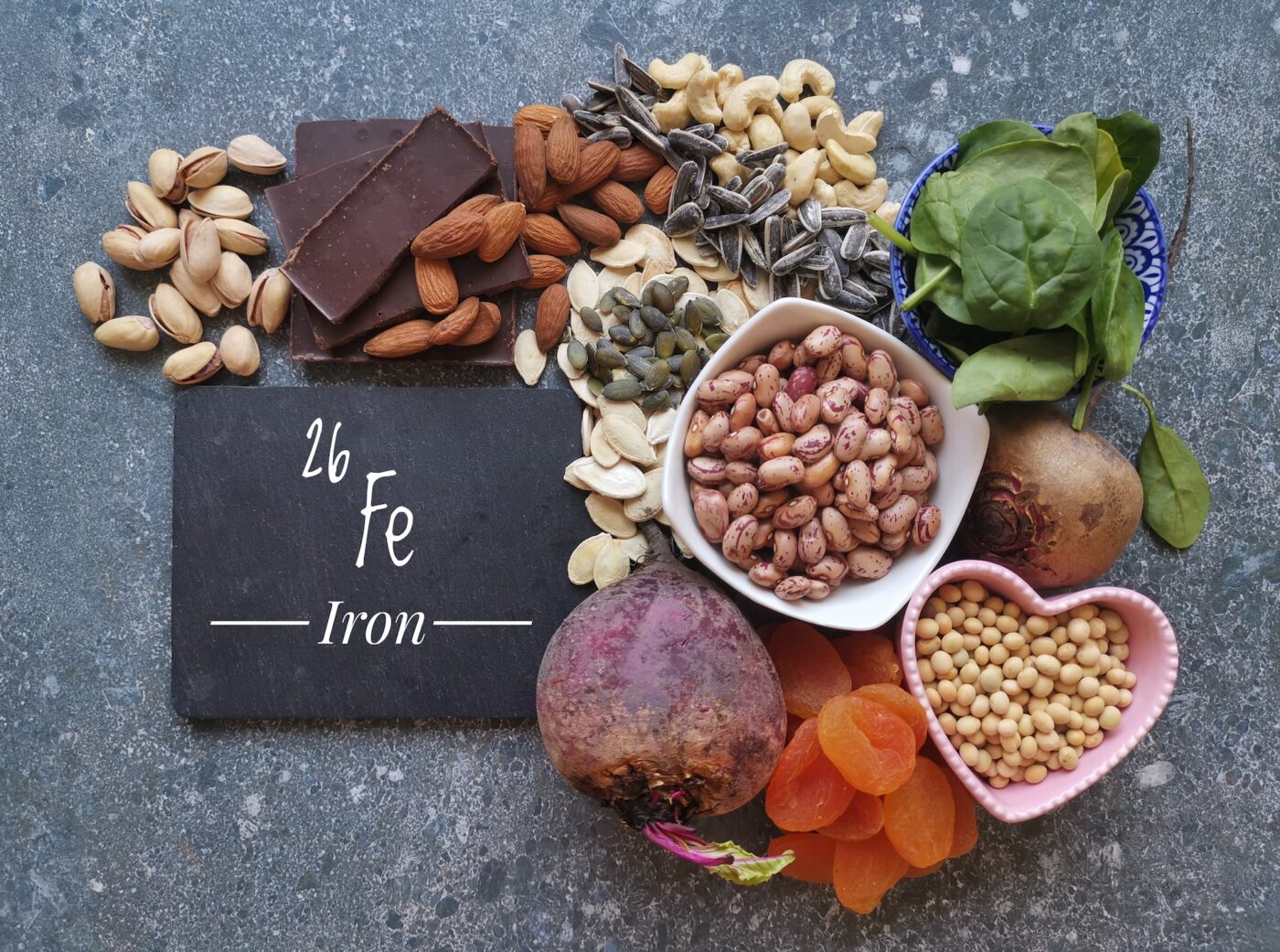A Guide to Iron-Rich Foods and Absorption Optimization
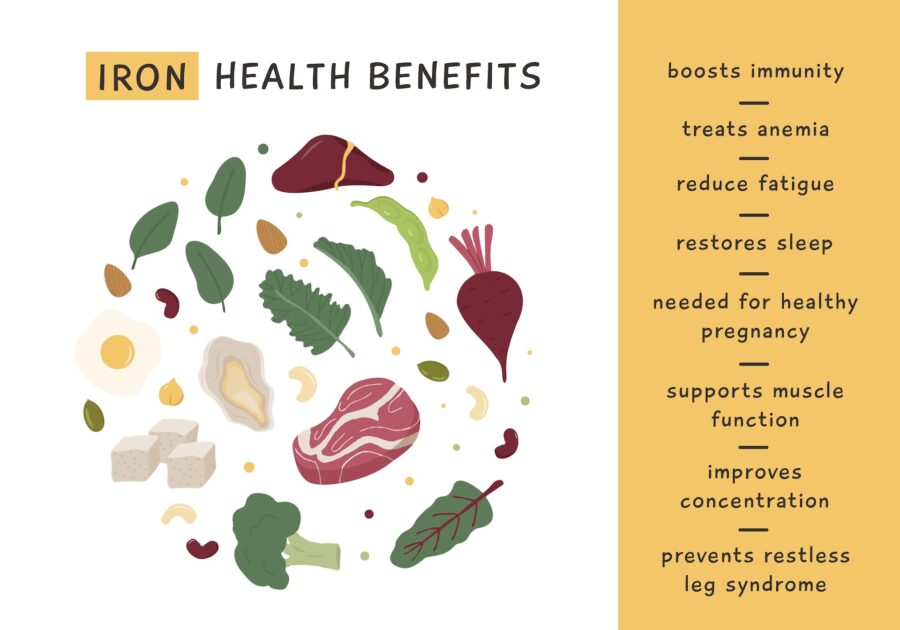
Iron is an indispensable mineral for sustaining vitality and well-being. It is a cornerstone of optimal health, from bolstering oxygen transport to supporting energy metabolism. However, iron deficiency remains a prevalent nutritional concern worldwide. The reasons include:
- Low dietary iron intake.
- Poor iron absorption.
- Chronic disease.
- Consuming medications that inhibit iron absorption.
To correct this, it’s imperative to explore a diverse array of iron-rich foods, encompassing both animal and vegetarian sources, while also understanding the factors influencing iron absorption. Many of our patients are vegetarian, vegan and pescetarian, which makes it harder to get adequate iron through diet. But it can be done!
In general, low blood levels of Iron is called anemia. Symptoms include:
- Fatigue and Weakness: Feeling tired and lacking energy, even after adequate rest, is one of the most prevalent symptoms of iron deficiency anemia.
- Pale Skin: Reduced hemoglobin levels can result in paleness, particularly noticeable in the face, lips, and inner lower eyelids.
- Shortness of Breath: Decreased oxygen-carrying capacity due to low hemoglobin levels can lead to breathlessness, especially during physical exertion.
- Dizziness or Lightheadedness: Insufficient oxygen delivery to the brain can cause feelings of dizziness, lightheadedness, or even fainting.
- Cold Hands and Feet: Poor circulation resulting from low hemoglobin levels can lead to cold extremities, such as hands and feet.
- Brittle Nails and Hair Loss: Inadequate iron levels can affect the health of nails, making them brittle and prone to breakage. Hair loss or thinning may also occur.
- Headaches: Reduced oxygen supply to the brain can trigger headaches, which may vary in intensity.
- Palpitations or Rapid Heartbeat: The heart may need to work harder to compensate for the reduced oxygen-carrying capacity of the blood, leading to palpitations or a rapid heartbeat.
- Cravings for Non-Food Items (Pica): Some individuals with iron deficiency anemia may experience unusual cravings for non-food items such as ice, dirt, or starch.
- Weakness and Difficulty Concentrating: Iron deficiency can impair cognitive function, leading to difficulties with concentration, memory, and mental clarity.
It’s important to note that these symptoms can vary in severity and may not necessarily indicate iron deficiency anemia alone. If you have these symptoms, it’s easy to diagnose with a simple blood test, and most iron deficiency anemia can be effectively managed by improving diet and iron supplementation.
Heme Iron and non-heme Iron are two forms of dietary Iron, each with distinct characteristics in terms of their sources, absorption rates, and roles in the body:
- Heme Iron:
- Source: Heme iron is found predominantly in animal-derived foods such as meat, poultry, and seafood.
- Structure: Heme iron is bound to a heme protein molecule, which gives it its characteristic red color.
- Absorption: Heme iron is highly bioavailable, meaning it is efficiently absorbed by the body. It is less influenced by factors that inhibit non-heme iron absorption.
- Role: Heme iron is a crucial component of hemoglobin and myoglobin, proteins responsible for oxygen transport and storage in the body.
- Non-heme Iron:
- Source: Non-heme iron is primarily found in plant-based foods such as legumes, dark leafy greens, nuts, seeds, and fortified grains.
- Structure: Non-heme Iron is not bound to heme proteins and exists in various chemical forms within plant foods.
- Absorption: Non-heme iron has lower bioavailability than heme iron and is influenced by dietary factors that can enhance or inhibit its absorption.
- Role: While non-heme Iron also contributes to the body’s iron stores and various physiological processes, its absorption is generally lower and can be affected by dietary and physiological factors.
Heme iron is primarily sourced from animal products and is more efficiently absorbed by the body, whereas non-heme Iron is found in plant-based foods and is subject to more significant variability in absorption influenced by dietary factors. Both forms of Iron are essential for maintaining optimal health and preventing iron deficiency.
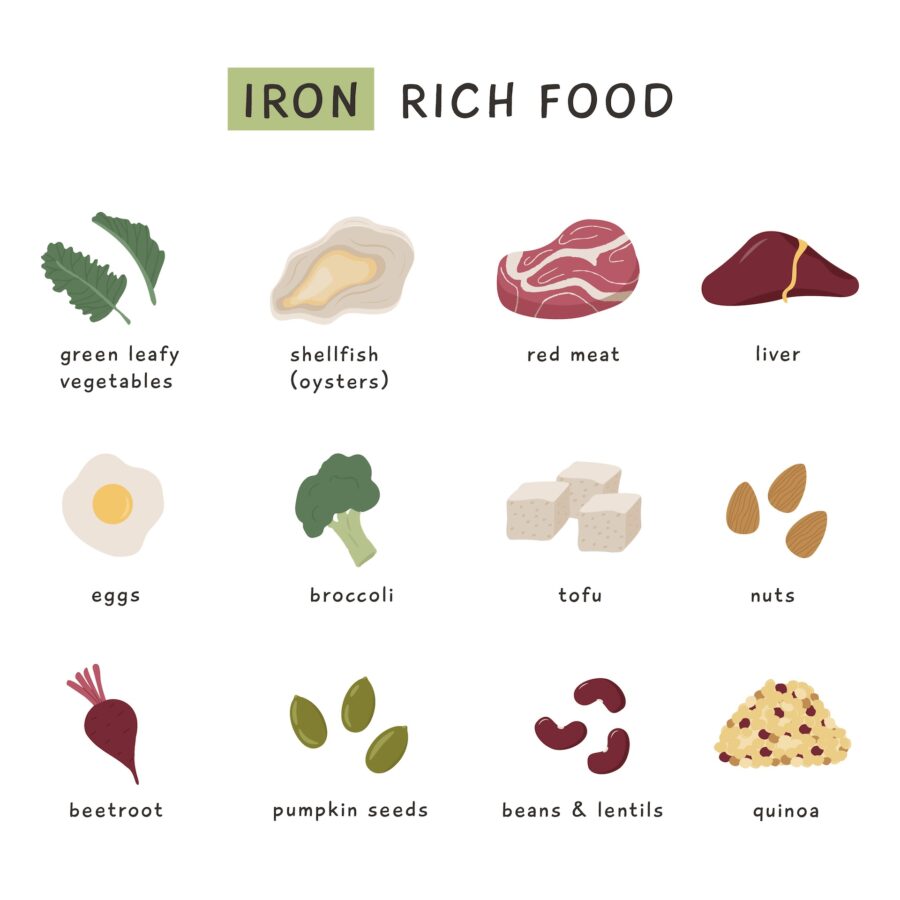
Animal Sources:
1. **Lean Red Meat:** Beef, lamb, and pork are renowned for their rich heme iron content, which boasts high bioavailability. For instance, a 3-ounce serving of beef provides approximately 2.1 mg of Iron [1].
2. **Poultry:** Focus on eating dark meat and organ meats like liver, which offer substantial amounts of heme iron. A 3-ounce serving of cooked chicken contains around 1.1 mg of iron [2].
3. **Seafood:** Shellfish such as clams, oysters, and mussels are exceptional sources of heme iron, with a 3-ounce serving of cooked clams providing approximately 23.8 mg of Iron [3].
Vegetarian Sources:
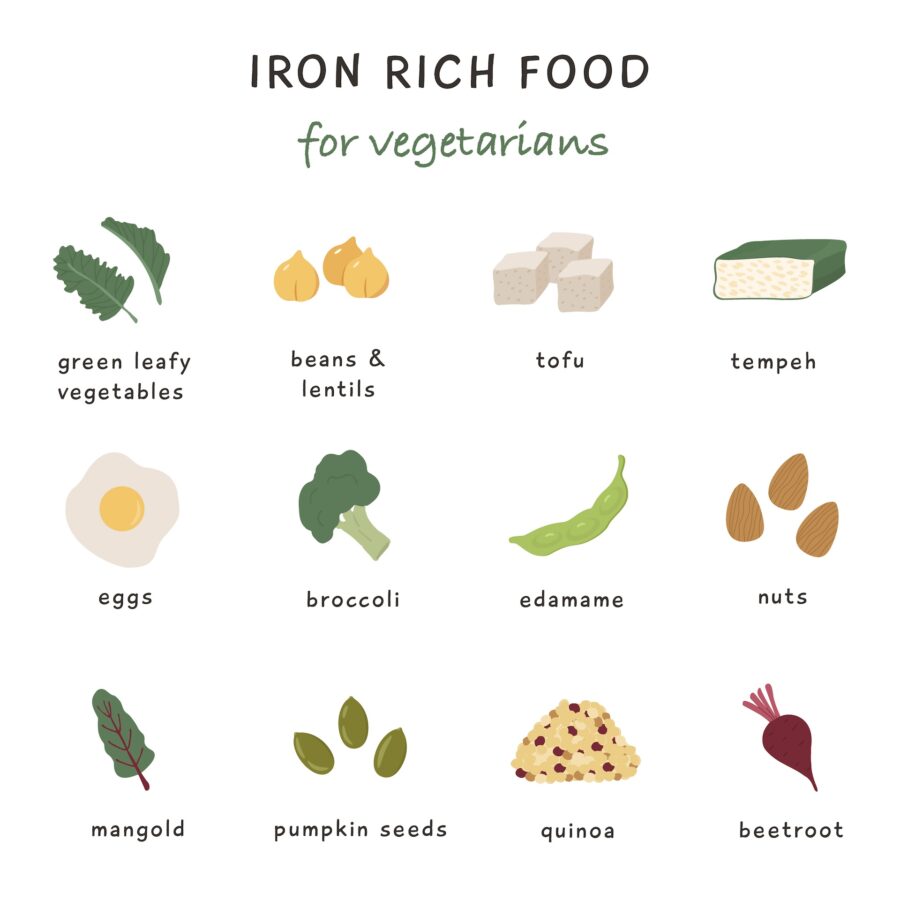
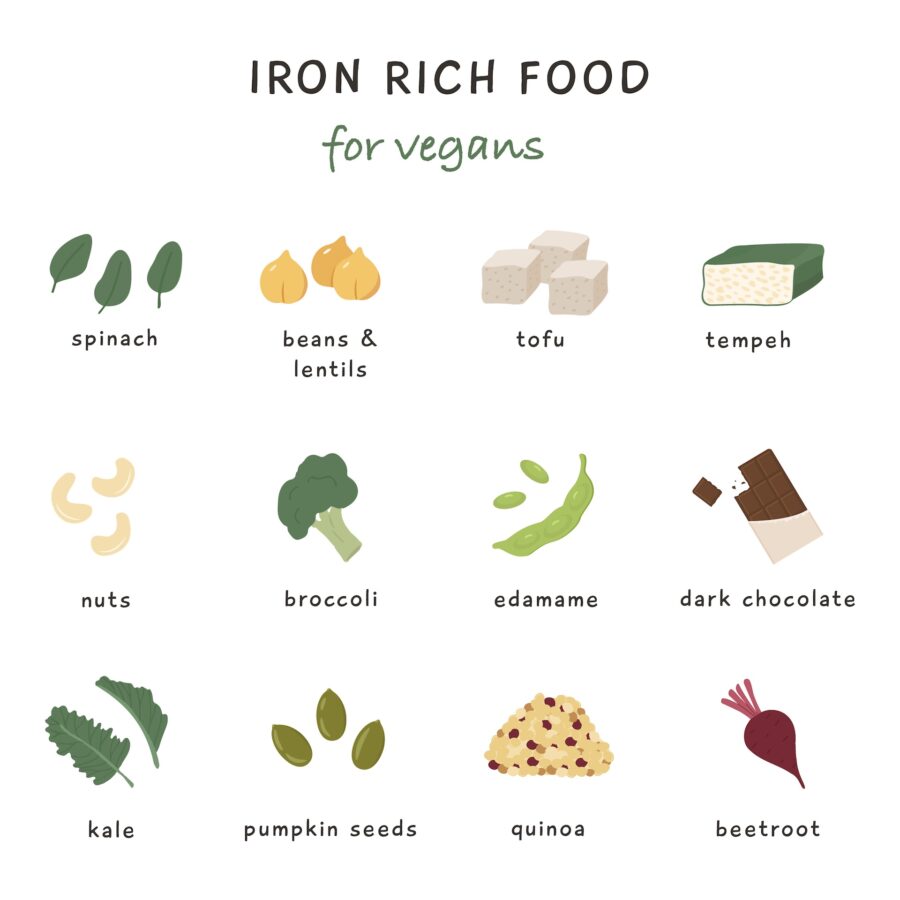
1. **Legumes:** Beans, lentils, and chickpeas are plant-based powerhouses, rich in non-heme Iron, protein, and fiber. For example, a cup of cooked lentils contains approximately 6.6 mg of Iron [4].
2. **Dark Leafy Greens:** Spinach, kale, and Swiss chard offer substantial amounts of non-heme Iron, albeit with slightly lower absorption rates. A cup of cooked spinach contains around 6.4 mg of iron [5].
3. **Tofu and Tempeh:** Soy products like tofu and tempeh are excellent vegetarian sources of Iron and protein. A 1/2 cup of tofu provides approximately 3.6 mg of Iron [6].
Surprising Sources:
1. **Seaweeds:** Certain seaweeds, including spirulina and nori, are surprisingly rich in Iron. For instance, 2 tablespoons of spirulina offer about 8 mg of iron [7].
2. **Black Cherries:**. A cup of black cherries contains around 0.9 mg of iron [8].
3. Nettles: One cup of nettle tea contains 1.5 mgs of Iron. Since it’s a great source of B and C vitamins, it’s a powerhouse for raising hemoglobin levels.
4. Chia Seeds: One ounce, or 2 tablespoons, contains about 2.2 mgs of Iron. They are also loaded with healthy fats and calcium.
5. Blackstrap Molasses: One tablespoon contains a whopping 3.5 mgs of Iron.
6: Cacao: Bring on the chocolate! 3 oz of high-flavanol cocoa or cacao nibs has 7 mgs of Iron!
Factors Influencing Iron Absorption:
Enhancers:
1. **Vitamin C:** Consuming foods rich in vitamin C alongside iron-rich meals significantly enhances iron absorption. Citrus fruits, strawberries, and bell peppers are excellent sources of vitamin C. This is especially true for non-heme Iron.
2. **Cooking in Cast Iron Skillets:** Cooking acidic foods such as tomatoes or vegetables in cast iron cookware can increase their iron content, which is particularly beneficial for individuals with low iron levels.
Inhibitors:
1. **Calcium:** Dairy products and calcium supplements can inhibit iron absorption when consumed simultaneously. It’s advisable to consume calcium-rich foods separately from iron-rich meals [9].
See our Blog on Dairy Free Calcium Rich Foods
2. **Phytates and Tannins:** Found in whole grains, nuts, seeds, tea, and coffee, phytates and tannins can interfere with iron absorption. Soaking, sprouting, or fermenting these foods can help mitigate their inhibitory effects [10].
Recommended Daily Intake:
Iron’s recommended dietary allowance (RDA) varies by age, gender, and life stage. For adult men aged 19-50, the RDA is 8 mg per day, while for adult women in the same age group, it’s 18 mg per day due to menstrual losses. During pregnancy, the RDA increases to 27 mg per day [11].
Incorporating a range of iron-rich foods into your diet, coupled with mindful eating habits, can help meet your body’s iron needs and promote overall health and vitality. Whether opting for animal or vegetarian sources, nature offers many options to support your well-being.
A final precaution about supplementation: If you have anemia due to a chronic disease, such as Crohn’s or Ulcerative Colitis, avoid supplementing with Iron, as it can exacerbate the disease.
Most people find Iron is constipating. Choosing a food-based iron, like Floradix, can avoid or minimize this. Or eating a couple of prunes ( also a good source of Iron)
Citations:
1. USDA FoodData Central
2. USDA FoodData Central
3. USDA FoodData Central
4. USDA FoodData Central
5. USDA FoodData Central
6. USDA FoodData Central
7. National Institutes of Health: Office of Dietary Supplements
8. National Institutes of Health: Office of Dietary Supplements
9. Harvard T.H. Chan School of Public Health: The Nutrition Source
10. National Institutes of Health: Office of Dietary Supplements
11. National Institutes of Health: Office of Dietary Supplements
